This is a Veteran Owned site
![]()
 |
The Tormek TT-50 Truing Tool uses dials rather than your fingers to move the cutter across the stone. Click image to enlarge |
TORMEK TT-50 Truing Tool
Dial-operated truing
Text, photos & video by Tom Hintz
Posted – 1-28-2007
Grinding wheels used for sharpening must be trued occasionally, that is a fact of life. What many do not realize is that this corrective resurfacing actually extends the life of a stone grinding wheel even though a small amount of material is removed in the process. Truing the wheel also makes it easier to get a fine edge and to do it faster.
The new Tormek TT-50 Truing Tool features a solid body with a fork that indexes it to the leg of the support bar for stability. While the diamond impregnated copper cutter is very similar to previous truing tools, it is now mounted on a lead screw that moves it across the stone. This screw and the finger knobs at either end eliminates having to push the cutter by hand and makes getting a smooth surface easier. Also, adjusting the height of the support bar sets the depth of cut rather than positioning the locking loop as on the previous version.
Setup
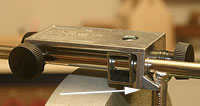 |
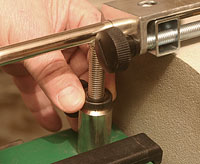 |
(left) The TT059 has a "foot" that hooks around the support arm post to lock in the angle of the body. (right) Cutting depth is set by raising the micro-adjust nut and then lowering the support arm to achieve the desired cut. Click images to enlarge |
|
The Tormek TT-50 Truing Tool slides onto the support bar, which is mounted in the vertical mounts. The fork is placed around the leg of the support bar and a finger-tightened knob locks the jig in place.
Note: Because of a difference in the vertical mount locations, the Tormek TT-50 Truing Tool will not work on the JET Wet Sharpener.
The instructions say to lower the support bar with the micro adjusting nut (with the machine running) until the cutting tip just touches the highest point of the grinding wheel. Shut the machine off, move the cutting tip off of the stone surface and lower it a maximum of 0.03” (0.75mm) by turning the micro adjusting nut upwards. Reposition the support bar so the micro adjusting nut is in contact with the mount, the support bar level and lock it down. The Tormek TT-50 Truing Tool should now be set to make the cut.
During testing I discovered a bit of play between the bar the cutting point is mounted in and the body of the jig that required a bit of compensation in order to get a true baseline setting. More on this later in this story.
Lead Screw
 |
The cutter is mounted in a bar that is threaded over the screw that drives it from side to side. Click image to enlarge |
Using a lead screw to move the cutter across the stone smoothly has become popular over the last couple of years and the new Tormek TT-50 Truing Tool includes their version of that feature. The TORMEK lead screw is a single threaded shaft with finger knobs on either end. Turning either of the knobs slowly moves the cutter in a predictable manner that is capable of creating a very smooth surface that was not easily made with the older, finger-pushed version of the Truing Tool.
In the Shop
I installed the Tormek TT-50 Truing Tool to the support bar as per the multi-language instruction sheet, and saturated the grinding wheel with fresh water.
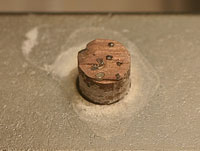 |
The diamond chips that actually do the cutting are embedded in a copper plug. The chips may not be visible until after a cut or two wears away the initial copper covering them as in this photo. Click image to enlarge |
The instructions say to lower the support arm until the cutter touches the highest spot of the stone using the micro adjusting dial. Once the contact is made, the instructions say to move the cutter off the side of the stone and lower the support arm a maximum of 0.03”. However, there is a small amount of play between the cutter holder and the body of the Tormek TT-50 Truing Tool that allows the cutter to continue to move upwards slightly before it is actually seated. I found that checking the rear of the cutter holder while lowering the support arm to be sure no vertical play remains produced a true initial setting.
I suspect that the small amount of vertical play along with an equally small amount of lateral play in the cutting tip holder contribute to vibrations heard and felt in some truing situations. The instructions packed with the Tormek TT-50 Truing Tool warn about these vibrations when moving the cutter too slowly across the stone. The differential between the slow feed rate the Tormek TT-50 Truing Tool was designed for and too slow is small but relatively easy to distinguish, primarily because of the vibration.
It appears that turning the feed dials too slowly reduces the load on the cutter and allows it to vibrate. This vibration was especially noticeable when the cutter alternated from a full depth cut to a shallower one while truing a grinding wheel with even a minor out-of-round condition.
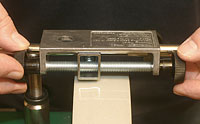 |
Actually making the cut is a matter of turning the dials slowly to move the cutter across the stone. Go too slow for the stone condition and the TT-50 wants to vibrate. The instructions that come with the TT-50 warn of this situation. Click image to enlarge |
While the instructions specify a maximum cut depth of 0.03”, I found that to be inadequate for correcting a grinding wheel with an out-of-round condition that was visible to the eye. I trued two TORMEK grinding wheels with barely perceptible out-of-round conditions and both required a second cut to fully true the surfaces. In both cases, the initial cut was made at 0.03” depth and the second at about 0.02”. Both wheels were fully surfaced with the second cut. This two-step truing was also necessary with the previous finger-operated truing jig. Taking a cut of sufficient depth to true the wheel in a single pass can create enough force to risk breaking the edges of the wheel.
TORMEK literature claims that the grinding wheel can be used immediately after truing with the Tormek TT-50 Truing Tool, without further refinement of the surface with the grading stone. Technically that is true, particularly if a very aggressive surface is needed. Throughout testing I felt that the trued surface needed 10 to 15 seconds of smoothing with the fine side of the grading stone for general sharpening. If you have a tool that needs reshaping before sharpening, the surface left by the Tormek TT-50 Truing Tool might be just right.
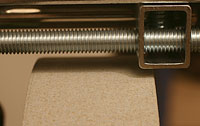 |
Tormek literature claims the freshly cut surface left by the TT-50 can be used as is for grinding. In our testing, that was only true is a very aggressive stone was wanted. I was unable to produce a surface that did not require smoothing with the grading stone before use. Click image to enlarge |
The Tormek TT-50 Truing Tool has knobs on both ends that allow continuous movement of the cutter across the stone. Being able to maintain uninterrupted movement of the cutter did not seem to be an issue in terms of surface quality during testing. I intentionally stopped the cutter several times during a truing cut (machine running) without producing perceptible lines or grooves. If continuous movement was the design issue, the second knob fixes a problem that didn’t exist. I suspect having knobs on both ends of the Tormek TT-50 Truing Tool will be most useful to left handed users.
One liability of the dual-knob setup is that it encourages the user to unconsciously rest their hands on the support bar while making the cut. Since a single cut across the wheel can take two to three minutes, the hands can unintentionally rest on and apply downward pressure to the support bar and cutter. Though I didn’t think I was pressing down, the sound of the cutter changed noticeably when I consciously lifted my hands from the support bar while cutting. I was not able to see a change in the surface of the grinding stone but do think letting the support bar carry the weight of your hands is a habit to be avoided.
Conclusions
See It Work |
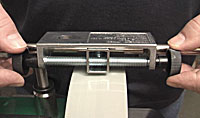 |
Overall the Tormek TT-50 Truing Tool performed as expected and did create a flat, square surface. As noted earlier, I felt the surface it creates requires touching up with the grading stone but you may feel differently depending on the grinding job at hand. The vibration problem appears to be more annoying than detrimental to the cut or to the Tormek TT-50 Truing Tool itself. It is important to note that my evaluation was limited to 9 full-width cuts (total) on two different TORMEK wheels. Testing was not extensive enough to determine if the vibration, though relatively consistent, would cause damage to the Tormek TT-50 Truing Tool over long-term use. Based on what I have seen during this evaluation, this seems unlikely.
With a street price of $63.95 (1-26-2007) the Tormek TT-50 Truing Tool certainly isn’t free but considering how truing grinding wheels extends their life and improves performance, this is a good investment if you do not already have a stone truing tool like the older Tormek ADV-50D Diamond Truing Tool.
Related Reviews
JET & Tormek Wet Sharpener Comparison
JET Slow-Speed Wet Sharpener Review
Pricing Link |
Have a comment on this review? –Email Me!
Back to the Tool Reviews list.
All written, photographic and drawn materials are property of and copyright by NewWoodworker.com LLC 2000-2019. Materials may not be used in any way without the written permission of the owner.
